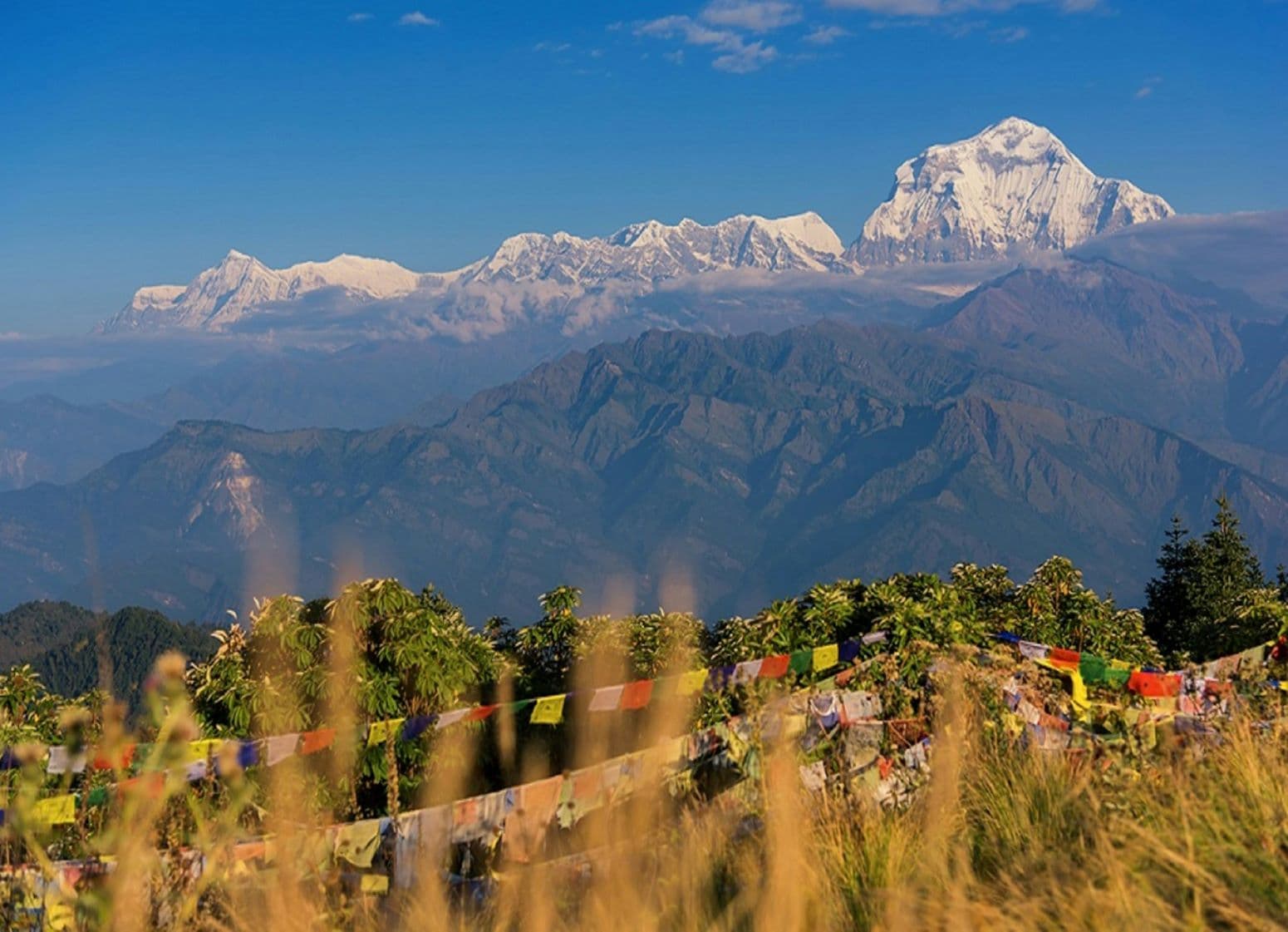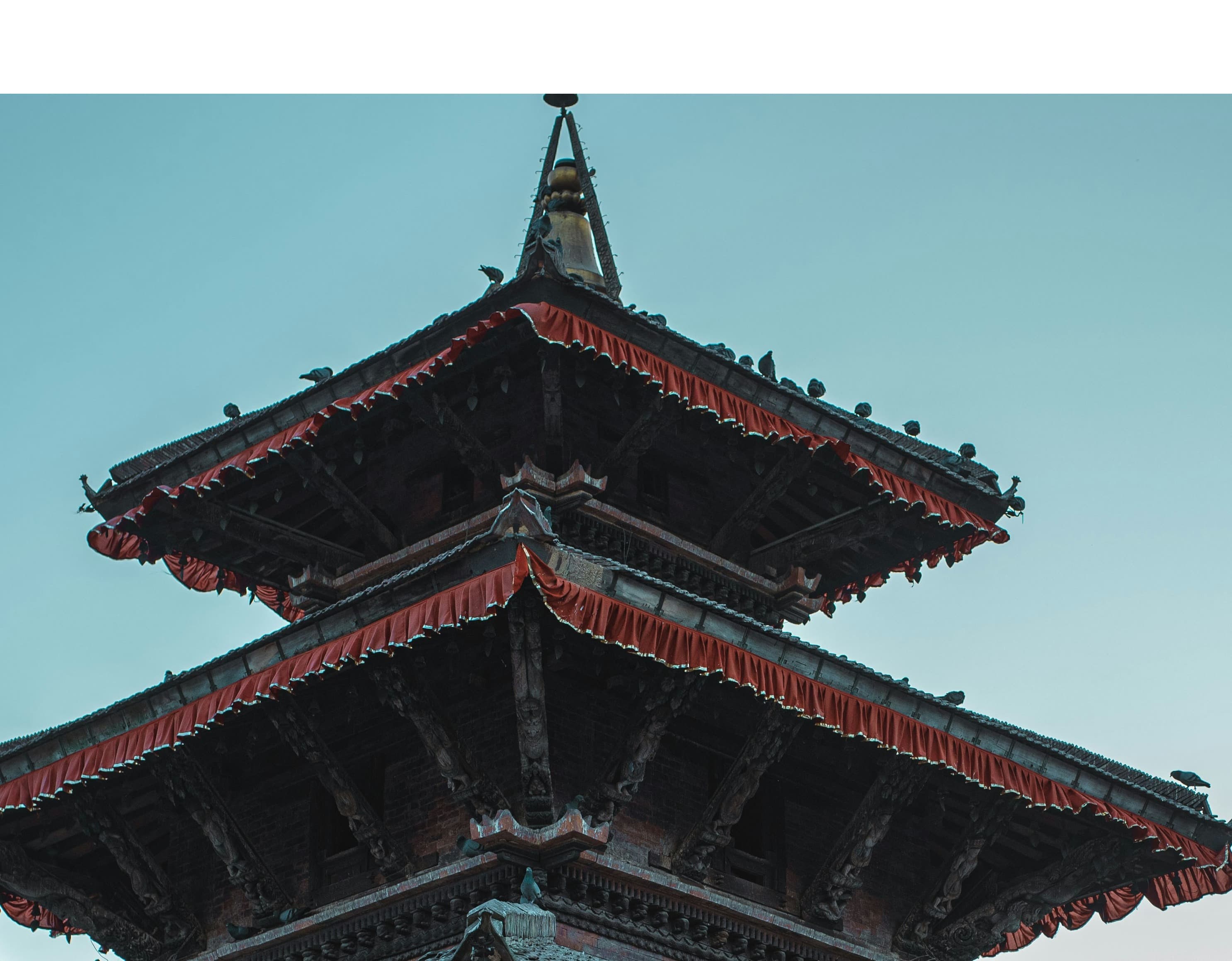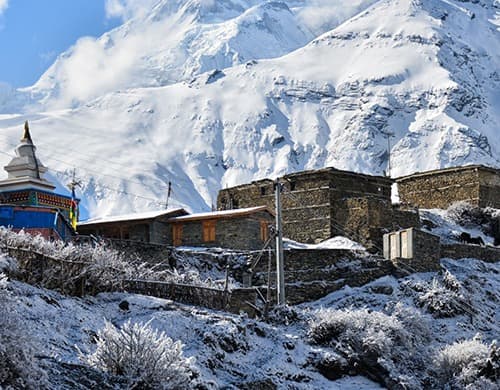"Embark on the scenic Ghorepani Trek, beginning and ending at Naya Pool, nestled in the renowned Annapurna region. This easy-grade trek is accessible by tourist bus and reaches a maximum altitude of 3,210 meters (10,503 feet) at the famed Poon Hill viewpoint. Experience breathtaking sunrise views over the Himalayas and traverse vibrant rhododendron forests, charming Gurung villages, and serene mountain landscapes. Accommodation in comfortable teahouses enhances this unforgettable Himalayan adventure, perfect for beginners and seasoned trekkers alike."
The Ghorepani Poon Hill trek is considered one of the premier short treks in the Himalayan region, perfect for adventurers of all ages, including families with children. This trek, ranging from 4 to 5 days, delves deep into the Annapurna sanctuary, offering a quintessential Himalayan experience. Poon Hill, at an altitude of 3,210 meters, serves as an exceptional vantage point for panoramic views of the majestic Annapurna range, Dhaulagiri, Nilgiri, Tukuche, Varaha Shikhar, and Lamjung Himal.
Ascend to Poon Hill to witness a breathtaking sunrise illuminating the snow-capped peaks—a truly memorable spectacle.
The route traverses through vibrant villages and lush rhododendron forests, set against the constant, magnificent backdrop of the Annapurna mountains.
Ideal for both novice and seasoned trekkers seeking a concise Himalayan adventure, this well-trodden path offers comfortable accommodations and satisfying culinary options. The ever-photogenic Himalayan vistas provide a consistently stunning display of natural beauty, ensuring an unforgettable trekking experience.
A Typical Day on the Ghorepani Poon Hill Trek

Regarded as one of the more accessible treks in Nepal, the Ghorepani Poon Hill Trek balances ease with the need for a fair level of fitness—it's not just a step up from your living room! This trek is also family-friendly, welcoming children and older adults to enjoy its scenic routes.
Your adventure wraps up in Kathmandu, but begins and concludes with leisure days in picturesque Pokhara, situated within the Annapurna range. These bookend days in Pokhara set a serene tone for both the commencement and finale of your trek.
Set against a backdrop of snow-draped peaks and stunning landscapes, each day kicks off early, usually around 6 or 7 AM—except for the ascent to Poon Hill. On that day, you’ll start pre-dawn to reach the summit in time to witness a breathtaking sunrise over the Himalayas, then descend for a well-deserved breakfast before continuing your journey.
Following breakfast each day, your guide will lead the way, sharing insights about the surrounding vistas and naming the prominent peaks in view. Lunches are enjoyed at cozy teahouses along the trail.
Upon reaching the evening's teahouse, it's wise to order dinner early to allow ample preparation time. This is also a perfect opportunity to mingle with fellow trekkers and discuss the upcoming day’s itinerary with your guide.
Remember to order your breakfast before retiring for the night, and consider turning in early to rest up for the next day’s trek. This structured yet rewarding schedule enhances the overall experience, making each day on the Ghorepani Poon Hill Trek both memorable and manageable.
Equipment Checklist for Ghorepani Poon Hill Trek
Embarking on the Ghorepani Poon Hill Trek requires adequate preparation, especially in terms of having the right equipment. To ensure a comfortable and safe trekking experience, here is a comprehensive checklist of essential gear and equipment:
Clothing:
- Waterproof Jacket: Lightweight and breathable.
- Insulated Jacket: For cold mornings and evenings.
- Trekking Pants and Shorts: Quick-drying type is preferred.
- Thermal Underwear: Provides extra warmth at higher altitudes.
- Breathable T-shirts: Preferably moisture-wicking fabric.
- Long-Sleeve Shirts: For sun protection.
- Trekking Boots: Well-broken-in and suitable for mountain terrain.
- Trekking Socks: Wool or synthetic to keep your feet dry and comfortable.
- Hat and Gloves: Sun hat for the day and warm hat and gloves for the evening.
- Rain Gear: Durable raincoat or poncho.
Gear:
- Backpack: A 30-40 liter backpack for carrying your daily essentials.
- Sleeping Bag: Rated to at least 0°C, as nights can be chilly.
- Trekking Poles: Helpful for reducing strain on knees, especially during descents.
- Headlamp: With extra batteries for early morning or late evening activities.
- Water Bottle or Hydration System: To stay hydrated throughout the trek.
- Sunglasses: With UV protection.
Personal Items:
- Sunscreen: High SPF to protect against intense sun.
- Lip Balm: With SPF protection.
- Personal First-Aid Kit: Including medication for altitude sickness, plasters, and painkillers.
- Insect Repellent: Especially during the warmer months.
- Toiletries: Keep it light – toothbrush, toothpaste, biodegradable soap.
- Quick-Dry Towel: Compact and lightweight.
Miscellaneous:
- Camera: With extra memory cards and batteries.
- Notebook and Pen: For jotting down experiences.
- Snacks: Energy bars and trail mix to keep your energy up between meals.
- Plastic Bags: For waste and to keep wet clothes separate.
- Local Currency: For purchases and tips in more remote areas.
This checklist should cover all the essentials you need for a successful trek to Poon Hill, ensuring that you're prepared for various weather conditions and the physical demands of the trek. Always remember to pack light, as carrying too much can hinder your mobility and overall trek enjoyment.
Interesting Fact of Ghorepani Poonhill treks
Stunning Sunrise at Poon Hill Early risers trek up Poon Hill (3210 m) from Ghorepani, a brisk 45-minute to 1-hour ascent, to witness the sunrise. As the sun emerges over the eastern hills, the snowy peaks of the Himalayas are bathed in a dazzling golden light. This moment offers an extraordinary opportunity for capturing stunning photographs of the mountains aglow. The experience of the sunrise from Poon Hill is indescribable, a breathtaking spectacle that words alone cannot fully capture.
Panoramic Mountain Views on the Poon Hill Trek A key feature of the Poon Hill Trek is the expansive views of the Himalayan giants, including Mt. Dhaulagiri, the world’s seventh highest peak. The trek provides clear views of iconic mountains such as Annapurna I, Annapurna South, Annapurna II, Annapurna IV, Machhapuchhre, Tukuche Peak, Nilgiri, Himchuli, and Dhampus Peak, making it a photographer's and nature lover's paradise.
Short Trekking Holiday in Nepal: 4 Days at Ghorepani Poon Hill For those with a tight schedule, the 4 Days Ghorepani Poon Hill Trek fits perfectly into a week’s holiday in Nepal. This brief trek requires only four days of walking, making it accessible to people of all ages and fitness levels. Plan a short but rewarding trip to experience the majestic Himalayan scenery.
Rich Multiethnic Culture of the Ghorepani Region The Ghorepani area is home to the Gurungs and Magars, ethnic groups known for their rich cultural traditions and historical significance. Visitors have the unique opportunity to immerse themselves in local life, from observing festivals and daily rituals to learning about the storied history of these communities, famously known as Gurkhas.
Optimal Seasons for the Poon Hill Trek in 2024/2025\2026 While trekking is possible year-round, the optimal times for the Annapurna Sunrise Trek are during the spring (March-May) and autumn (September-October). These seasons offer the most favorable weather conditions, with the possibility of experiencing snowfall, adding an extra element of adventure to the trek.
Trek Difficulty: 3 Nights 4 Day or 04 Night 05 Days at Ghorepani Poon Hill The Ghorepani Poon Hill Trek is considered an easy route suitable for families, but it does include multiple uphill and downhill sections that can be physically demanding. Careful pacing and attention to walking technique, especially on descents, are important to avoid muscle strain.
Poon Hill Trek 3 Days: A Short Trekking Alternative For those pressed for time, the 3-day Poon Hill Trek from Pokhara is an excellent short route made possible by road access close to Nangethati. This trek offers a quick immersion into the high peaks and diverse cultures of the region, ideal for those seeking a brief yet fulfilling Himalayan experience.
Exploring Beyond Poon Hill: Side Treks and Extended Adventures After completing the Poon Hill trek, many adventurers choose to extend their journey with popular side treks such as the Mardi Himal Trek, Khopra Khair Lake Trek, Jomsom Muktinath Trek, 7 Days Annapurna Base Camp Trek, Mulde View Point Trek, and Mohare Danda Trek. These routes offer varied landscapes and further exploration of the Annapurna region.
Details Itinerary
Here is a detailed itinerary for the Ghorepani Poon Hill trek, breaking down the journey day by day to give you a clear picture of what to expect:
Day 1: Kathmandu to Pokhara (Drive)
- Altitude: 830 m / 2,723 ft
- Duration: 7 hrs
- Begin your adventure by traveling from Kathmandu to Pokhara, a scenic drive through the Nepali countryside. Pokhara is known for its tranquil lakes and stunning views of the Annapurna range, offering a picturesque start to the trek.
Day 2: Pokhara to Naya Pool (Drive) to Tikhe Dhunga
- Altitude: 1,570 m / 5,150 ft
- Duration: 6 hrs
- Depart Pokhara and drive to Naya Pool, where your trek officially begins. Trek through lush subtropical forests and alongside beautiful streams to reach Tikhe Dhunga, preparing you for the ascent ahead.
Day 3: Tikhe Dhunga to Ghorepani
- Altitude: 2,850 m / 9,350 ft
- Duration: 6 hrs
- Continue ascending steep stone staircases through rhododendron and oak forests. The day's trek brings you to Ghorepani, a charming village known for its spectacular panoramic views of the surrounding mountains.
Day 4: Ghorepani to Tadapani (Morning hike to Poon Hill)
- Altitude: 2,700 m / 8,858 ft
- Duration: 7 hrs
- Early morning hike to Poon Hill (3,210 m) to witness a breathtaking sunrise over the Himalayas. Enjoy stunning views of the Annapurna and Dhaulagiri ranges. Return to Ghorepani for breakfast, then trek to Tadapani, which offers beautiful forested landscapes and more intimate views of the mountains.
Day 5: Tadapani to Ghandruk
- Altitude: 1,940 m / 6,364 ft
- Duration: 3 hrs
- Trek downhill through dense forests filled with rhododendron trees to Ghandruk, a major settlement of the Gurung community. This village offers rich cultural experiences and closer views of Annapurna South, Hiunchuli, and Machhapuchhre.
Day 6: Ghandruk to Naya Pool to Pokhara (Drive)
- Altitude: 830 m / 2,723 ft
- Duration: 7 hrs
- Trek back to Naya Pool through terraced fields and rural landscapes. From Naya Pool, you will take a drive back to Pokhara, allowing you some rest and time to reflect on the trek as you enjoy the comforts of the city.
Day 7: Pokhara to Kathmandu (Drive)
- Altitude: 1,300 m / 4,265 ft
- Duration: 8 hrs
- Return to Kathmandu from Pokhara by road, wrapping up your trek with beautiful memories of the Annapurna region. This journey back to the capital city marks the end of your trekking adventure.
This itinerary offers a well-rounded experience, combining challenging treks with cultural immersion and natural beauty, ideal for those looking to explore the Himalayas over a manageable period.
FAQs of Ghorepani Poonhill treks
-
Do I need to get permits for the Poon Hill trek? Yes, you need two permits for the Poon Hill trek: the Annapurna Conservation Area Permit (ACAP) and the Trekkers' Information Management System (TIMS) card. These can be obtained in Kathmandu or Pokhara before starting the trek.
-
What is the height of the Poon Hill Trek? Poon Hill itself stands at an altitude of 3,210 meters (10,531 feet), offering some of the best sunrise and panoramic mountain views in the Annapurna region.
-
Are there any villages and teahouses in Poon Hill? While there are no villages or teahouses on Poon Hill itself, the trek passes through several villages such as Ulleri, Ghorepani, and Ghandruk, which have a good number of teahouses providing accommodations and meals to trekkers.
-
What is the difficulty level of the Poon Hill Trek? The Poon Hill Trek is considered an easy to moderate trek. It involves some steep staircases and hill climbs, but it's generally doable for individuals with average fitness levels and does not require prior trekking experience.
-
What are the mountains seen from the top of Poon Hill? From the summit of Poon Hill, you can see a breathtaking array of high Himalayan peaks, including Annapurna South, Annapurna I, Annapurna II, III, and IV, Dhaulagiri, Lamjung Himal, Gangapurna, and Machhapuchhre (Fishtail Mountain).
-
Do I need to get travel insurance for the Poon Hill Trek? Yes, it's highly recommended to get travel insurance for the Poon Hill Trek. Ensure that your insurance covers high altitude trekking up to 4,000 meters, medical expenses, and possible emergency evacuation.
-
What are the accommodations, food, and drinking water on the Poon Hill Trek route? Accommodations are primarily teahouses that provide basic rooms and communal bathrooms. Food along the trek is varied, ranging from traditional Nepali dishes to common western foods. Safe drinking water is available for purchase at teahouses, and it's advisable to use water purification tablets or a water filter.
-
When is the best time to do the Ghorepani Poon Hill Trek? The best times to undertake the Ghorepani Poon Hill Trek are during the spring (March to May) and autumn (September to November) seasons, when the weather is clear and dry, offering the best views of the mountains.
-
Are there any fixed departure dates? Can I do a solo private trek? Many trekking agencies offer fixed departure dates for group treks. However, you can also arrange a private solo trek through most agencies to suit your personal schedule and preferences.
-
Is there a risk of altitude sickness? Do I need to get travel insurance for Ghorepani Poon Hill Trek? The risk of altitude sickness on the Poon Hill Trek is relatively low, as the maximum elevation is 3,210 meters. However, it is still advisable to be cautious and acclimatize properly. As for travel insurance, it's important for covering any health issues, injuries, or evacuations during the trek.
-
Is tipping necessary for porters and guides? Yes, tipping is customary and greatly appreciated by guides and porters in Nepal. It is not mandatory but is a nice way to show appreciation for their hard work and assistance during the trek.



